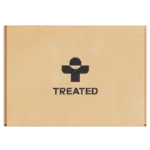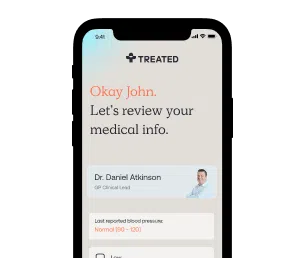Impetigo
Effective antibiotics to speed up recovery.
Secure delivery
UK clinicians
Impetigo is a bacterial infection that causes sores to appear on the face, arms, legs or abdomen. Although it’s mostly harmless, it is highly infectious, so early treatment is recommended.
Talk to us about your health to get recommendations from our experts. Order impetigo treatment online and get it the next working day.
Impetigo is a bacterial infection that causes red, itchy sores with yellow scabs. It’s caused by one of two bacteria: group A Streptococcus or Staphylococcus aureus. This bacteria tends to get into breaks in the skin like cuts, insect bites or other injuries (primary impetigo), or into sores caused by existing conditions like eczema (secondary impetigo). It’s a relatively harmless condition that tends to clear up on its own after a few weeks, but treatment is usually recommended to speed up recovery and reduce the risk of spread. This usually involves topical antibiotic creams for mild cases, or oral antibiotics (tablets) for more severe or widespread cases.
Although impetigo isn’t usually serious, it is very contagious. And in rare cases it can cause complications, especially for people who have a weakened immune system. It tends to affect children more than adults, and is more common in warmer, humid climates (such as the tropics and subtropics). In milder climates such as the UK, it’s more commonly seen in the summer months.
Anyone can get impetigo, but it’s more common in children and people who live in hot and
humid climates. It’s also more common in crowded conditions, such as schools, nurseries and military barracks.
It’s likely more common in children due to poorer hygiene and an increased close physical contact, such as during play. There’s also a theory that it’s more common in warmer, humid climates because insect bites are more common in these regions, which can serve as a starting point for the infection.
Because it’s highly transmissible, impetigo is a pretty common skin condition, making up around 10% of all skin conditions in children. The global prevalence of impetigo is thought to be around 11.2%, which breaks down to around 12.3% in children and 4.9% in adults. This data is contested, though, as it’s thought to be based heavily on data from developing countries, where the condition spreads more easily.
By comparison, in the UK, it’s estimated to affect 2.8% for children under four and 1.6% for children aged 5-15 every year. Other global estimates suggest that around 162 million children have impetigo at any given time.

How we source info.
When we present you with stats, data, opinion or a consensus, we’ll tell you where this came from. And we’ll only present data as clinically reliable if it’s come from a reputable source, such as a state or government-funded health body, a peer-reviewed medical journal, or a recognised analytics or data body. Read more in our editorial policy.
Impetigo is usually caused by one of two kinds of bacteria (group A Streptococcus or Staphylococcus aureus) infecting a break in your skin, but it can infect unbroken skin too. When it infects a cut, bite or other injury in your skin it’s called primary impetigo, and when it infects skin broken by an existing condition, such as eczema or head lice, it’s called secondary impetigo.
Because impetigo doesn’t normally cause any symptoms for around 4-10 days, it can be easy for you to spread it without knowing through close contact or shared fabrics like towels, flannels and clothes.
Risk factors that make it more likely for you to get impetigo include:
There are two kinds of impetigo: bullous and non-bullous. Non-bullous is the most common type, and the symptoms usually go like this:
These sores typically aren’t painful, but they may be itchy. Other symptoms like a fever or swollen glands might occur but only in rare, severe circumstances.
Bullous impetigo first appears as fluid-filled blisters called bullae, normally around the abdomen, face and legs. These bullae tend to be around 1-2 cm across, and they can quickly spread before bursting after several days. This usually leaves a yellow crust that heals without scarring.
With bullous impetigo, sores caused may be painful as well as itchy, and swollen glands and fever are more common.
It’s quite rare for impetigo to lead to any other problems, but it can happen.
Some complications associated with impetigo can include:
Impetigo doesn’t tend to leave scars, but it can happen in rare cases (especially if you scratch and pick at the sores).

How we source info.
When we present you with stats, data, opinion or a consensus, we’ll tell you where this came from. And we’ll only present data as clinically reliable if it’s come from a reputable source, such as a state or government-funded health body, a peer-reviewed medical journal, or a recognised analytics or data body. Read more in our editorial policy.
Primary impetigo is normally treated with antibiotics, while secondary impetigo might be approached by treating the underlying cause (such as eczema) first. Antibiotic creams are usually prescribed for mild cases of impetigo, whereas tablets might be recommended for more severe or widespread cases, or for cases where cream hasn’t worked to clear up the infection.
Antibiotic cream is applied to the affected area, typically two to four times a day for around a week. Before you apply the cream to your skin, the affected areas should be washed with warm, soapy water to gently clear off any loose scabs, and after application you should wash your hands thoroughly to remove any excess cream (or wear gloves during application).
Similarly, antibiotic tablets (when recommended), should also be taken 2-4 times a day for around a week. It’s important that you take your full course of antibiotics if they’ve been prescribed to you, even if you feel better with some tablets left over.
Common side effects of antibiotic cream can involve irritation and redness, whereas antibiotic tablets may cause nausea, vomiting or diarrhoea.
General measures to follow when treating impetigo are:
Although impetigo tends to get better on its own without treatment, antibiotic cream is usually recommended. This is because impetigo is a very infectious condition, so the quicker it’s dealt with, the less likely transmission becomes. And because antibiotic cream is less likely to cause side effects than tablets, it tends to be the go-to option for milder cases.
Self-help measures are also recommended to ease symptoms and reduce the risk of spreading it. These include making sure that the sores are covered at all times, and that you stay at home from school or work until the sores have dried-up and blistered over (or until at least 48 hours after starting treatment). You should also avoid sharing any towels or flannels, and wash them at a high temperature after use.
Impetigo doesn’t need treatment (it usually clears on its own in a couple of weeks), but it is still recommended to speed up recovery and reduce transmission risk. If you’re not taking treatment for impetigo, you should make sure to clearly follow clinical advice to avoid spreading or worsening your condition. Making sure the sores are covered at all times, following good hygiene practices such as hand-washing and refraining from touching or scratching the sores as much as possible are all important. You should also make sure you contact a clinician as soon as possible if your condition worsens.

How we source info.
When we present you with stats, data, opinion or a consensus, we’ll tell you where this came from. And we’ll only present data as clinically reliable if it’s come from a reputable source, such as a state or government-funded health body, a peer-reviewed medical journal, or a recognised analytics or data body. Read more in our editorial policy.
Have something specific you want to know? Search our info below, or ask our experts a question if you can’t find what you’re looking for.
Seasonal occurrence of impetigo: a retrospective 8-year review (1996-2003). Clinical and Experimental Dermatology, [online] 30(5), pp.512–514.
Impetigo: All You Need to Know | CDC. [online]
The association between impetigo, insect bites and air temperature: a retrospective 5-year study (1999–2003) using morbidity data collected from a sentinel general practice network database. Family Practice, [online] 23(5), pp.490–496.
Non-bullous Impetigo: Incidence, Prevalence, and Treatment in the Pediatric Primary Care Setting in Italy. Frontiers in Pediatrics, [online] 10.
The Global Epidemiology of Impetigo: A Systematic Review of the Population Prevalence of Impetigo and Pyoderma. PLoS ONE, [online] 10(8).

Flucloxacillin is an antibiotic that can treat skin infections within a couple of days.

Antibiotic tablets taken twice daily to clear impetigo infections. Available in two doses.

Contains four active ingredients that fight infections and hydrate your skin at the same time.

Registered with GMC (No. 4624794)
Meet Daniel
Registered with GPhC (No. 2202465)
Meet Sanjeda
Registered with GPhC (No. 2070724)
Meet Craig
Always read the leaflet that comes with your medication and tell us about any side effects you get.
We know health, but you know you.
Our experts tell you what’s safe, but you decide what’s best.
Answer a few questions and tell us about yourself. Get tailored advice from our clinicians so you can choose better.

Choose your treatment and how often you have it delivered.

We know things change. It’s the nature of life. We’ll check in regularly to make sure your treatment is still right for you.
Pause. Change. Skip. Start again. Any time you like.
Here are some other things we can help with.
Choose from our range of tablets and solutions. Get ongoing care and support from our experts.
Stop smoking treatments that can help you kick the habit forever, and reduce your risk of disease.
Tablets or injections. Tailored weight loss treatments combined with ongoing support from our experts.
We're making healthcare more about you. Sign up to our newsletter for personalised health articles that make a difference.
Disclaimer: The information provided on this page is not a substitute for professional medical advice, diagnosis, or treatment. If you have any questions or concerns about your health, please talk to a doctor.
We couldn't find what you're looking for.
Here's everything we treat. Or, if you're looking for something we don't have yet, you can suggest something.
If there’s a particular treatment or condition you’re looking for, tell us and we’ll look into it for you.
Submit your question here, or tell us if you’ve found an issue on our site.
We’ll get back to you very soon. We aim to respond to all queries in one working day.
You’re signed up to our newsletter. Keep an eye on your inbox for our latest update.
By clicking 'Subscribe now' you're agreeing to our Privacy Policy.
We’ve sent you an email asking you to confirm your email address.